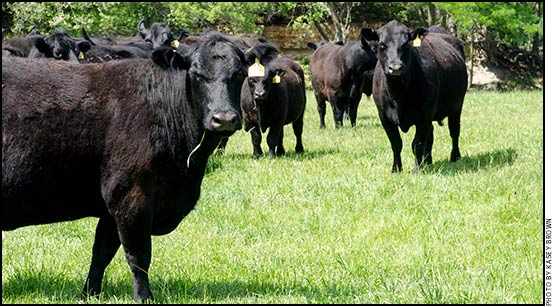
Cows Need Salt to Avoid Grass Tetany
Salt helps neutralize nitrates causing grass tetany.
Grass tetany, or grass staggers, affects mature cattle grazing lush forage after weather changes, like freezing early spring pastures or sudden growth after rainfall following drought.
This problem is associated with magnesium deficiency, calcium deficiency and excess potassium in the blood of affected animals. During cool, wet conditions or regrowth after frost or drought damage, sodium levels in certain forage plants plummet, while nitrogen and potassium levels spike. Recommended prevention has been supplemental dietary magnesium. Many producers feed high levels to try to prevent losses. Standard treatment for acute cases has been oral and/or intravenous magnesium.
After examining cattle lost in 2001 following spring frosts in the Midwest, Thomas Swerczek, a veterinary pathologist in the Department of Veterinary Science at the University of Kentucky (UK), found more clues about the cause and prevention of grass tetany.
A few years earlier, he collaborated with William McCaw, a veterinarian working with several purebred herds trying to find answers to health problems. Swerczek found a farm with healthy cattle where the owner was feeding loose salt rather than mineral mixes. Most farmers in that area fed mineral mixes and salt/mineral blocks, and he found that cattle often overate mineral mixes to get the little bit of salt in them.
The farmer with healthy cattle wasn’t feeding any magnesium.
“He’d been in the cattle business more than 40 years and had never had a case of grass tetany,” says Swerczek.
“This was a hint that maybe it wasn’t necessary to feed magnesium to prevent grass tetany. Later, when I got several problem herds off the mineral mix, they quickly turned around. Most of the cows had been suffering from diarrhea, wasting away, and within 24-48 hours they improved, after giving them plain loose salt instead of mineral,” he adds.
He was working with a herd of about 1,000 Angus and drove through that farm with the manager. They came across a cow that had been down for several days in spite of multiple treatments with magnesium and calcium.
Swerczek had some sea salt and put it in front of that cow. Three hours later she’d gotten up and wandered off. There were other cattle in the herd showing signs of grass tetany and going down. “I told the manager to put a handful of salt in front of them or get it into their mouths. Those cows came out of it,” he says.
“We had massive losses in Kentucky one year due to an unusual winter with warm spells. Grass and clover grew early, then we had a hard freeze in April. Cattle went down by the thousands with grass tetany and bloat. People were using bloat blocks, but this didn’t help, because they didn’t have salt. The farmers who had salt out didn’t lose cattle,” says Swerczek.
The reason cows go down with grass tetany is that they are short on magnesium and calcium, but he admits he didn’t know why salt worked. Then he discovered a connection between grass tetany and nitrates.
“We’d been taught that nitrate is not toxic — that nitrite is the problem, but I found that nitrate is 100 times more important in grass tetany than nitrite,” he says.
Why it works
The body must get rid of nitrate and it does this through the cations (ions having a net positive charge), especially sodium. “When there isn’t adequate salt in the blood, the body grabs onto the most available cation, which would be magnesium and then calcium,” he explains. When the spike of nitrate occurs — when the cow consumes frost-damaged forage — her body uses magnesium to combine with and get rid of the nitrate, which depletes the body’s magnesium, and this is why she goes down.
“If there’s enough salt available, the body can grab onto the sodium and cows don’t go down with grass tetany. If they don’t have salt on the day this hits, they go down. It has to be there all the time and it can’t be hard salt blocks because cattle can’t eat enough when they suddenly need it.”
Swerczek found that on some farms — even though farmers supplied salt — cattle weren’t eating enough of it. Potassium level in grass was spiking (15 times higher than normal) after a hard frost, especially when lush and highly fertilized.
“Since the cation potassium and sodium are so close together, these minerals can substitute for one another. When potassium spikes, even though cattle have salt available, they won’t eat it because the body thinks they already have enough.” They are sodium-starved, but their bodies didn’t know the difference between excess amount of potassium and too little sodium.
“The body is usually able to keep sodium levels within normal range, but when it drops, you only have a few hours before that animal dies. If you feed salt, and the animals eat it, they’ll be fine — as long as they have plenty of water,” Swerczek says.
Editor’s Note: Heather Smith Thomas is a cattlewoman and freelance writer from Salmon, Idaho.







